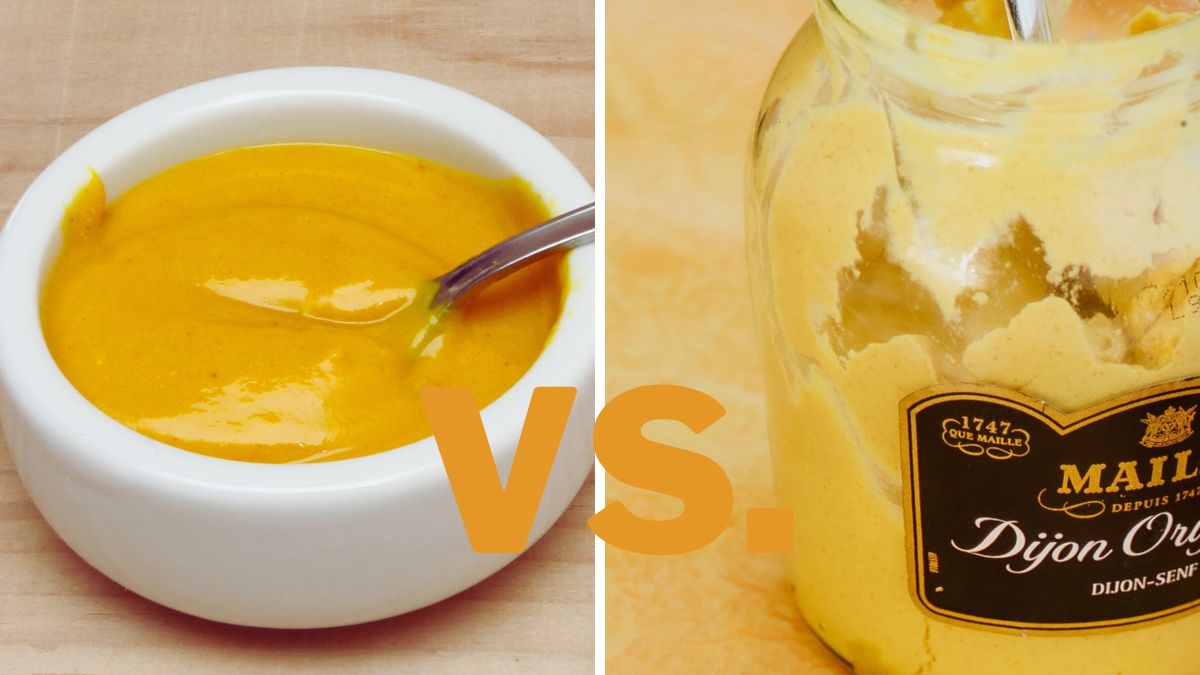English Mustard vs. Dijon: Differences & Uses

Mustard is one of my favorite condiments. There are so many varieties out there, but two of the most popular types are English and Dijon mustards. While they may seem similar at first glance, there are some key differences between these mustards that any aspiring foodie should know. So, what are the differences between English mustard and Dijon mustard?
While English mustard contains turmeric, Dijon gets its recognizable flavor from verjus and white wine. Dijon also has a smoother texture, while English mustard boasts a spicier flavor.
The ingredients, spiciness, appearance, and uses of English and Dijon mustards can vary quite a bit. I’ve investigated these two mustards to determine whether they can be used interchangeably. Spoiler alert: not always! Read on to become an expert in the differences between English mustard and Dijon mustard. By the end of this article, you will be thanking yourself for reading it!
Ingredients and Preparation
As a mustard connoisseur, I can tell you that English and Dijon mustards differ quite a bit in their ingredients and preparation.
English mustard is made from ground mustard seeds and turmeric, which gives it that bright yellow color. The seeds are usually brown and yellow mustard seeds, which tend to be more pungent. English mustard is prepared through a process called ‘wet grinding,’ where the mustard seeds are soaked in water before being ground into a paste. Some vinegar or wine is usually added as well.
On the other hand, Dijon mustard is made from white or yellow mustard seeds, which are more mildly flavored. The seeds are ‘dry ground’ without rehydrating them first. Verjuice, which is an acidic juice made from unripe grapes, is used instead of vinegar. Herbs like tarragon are also commonly added.
Appearance and Texture
Regarding appearance and texture, English mustard and Dijon mustard are quite different. I prefer Dijon’s smoother and creamier texture.
English mustard has a bright yellow color from turmeric, while Dijon has a pale grayish-yellow tint from white wine. The turmeric in English mustard gives it an intensely yellow, almost fluorescent hue. In contrast, Dijon’s color is much more muted and natural-looking to me.
English mustard has a coarse, grainy texture from the whole mustard seeds it contains. On the other hand, Dijon has a very smooth and creamy texture since the mustard seeds are ground more finely. Dijon’s silkier and more spreadable consistency is more pleasant to eat, in my opinion.
Flavor Profiles
English mustard has an intensely sharp, spicy kick, while Dijon boasts a tangy, zesty bite from white wine.
The spiciness of English mustard can be quite intense for those unaccustomed to it. The sharpness is balanced by subtle sweet and savory notes from spices like turmeric, cinnamon, and bay leaves.
In contrast, Dijon mustard has a tangy and zesty flavor from the white wine and verjus, the pressed juice of unripe grapes. It still has a kick from brown mustard seeds, but the overall taste is more complex, with hints of herbs like tarragon. The white wine and verjus mellow the spiciness, creating a tang that lingers on your tongue. Dijon’s flavor is versatile enough to pair well with most meats and cheeses.
Even though I love English mustard, I still make sure not to use too much of it at once because of its sharp kick. As you can see from this video, English mustard is not everyone’s cup of tea.
Heat Levels
Due to differences in ingredients and preparation, Dijon and English mustards also vary quite a bit in spiciness and kick. English mustard has a much hotter and spicier flavor from natural mustard oils that give it its heat. Dijon, which uses wine to tame the harshness of the seeds, has a milder, tangy, and zesty flavor with less heat by comparison.
English mustard gets its heat from brown and yellow mustard seeds, which contain compounds called glucosinolates that create a spicy flavor when mixed with water. The seeds are ground up and mixed with water and vinegar to make a paste. This process activates the compounds in the seeds and produces a strong, nose-clearing heat.
Dijon mustard gets its name from the region of France where it originates. It has a blend of brown and black mustard seeds that have been made less spicy through wine production.
The seeds are soaked in wine or verjus (unripe grape juice) before being ground, which reduces the potency of the compounds that create heat. Dijon has a mellow, tangy flavor with just a little kick of spiciness.
Uses

When it comes to uses, Dijon and English mustards can typically be substituted for one another, but there are some differences to keep in mind.
For sandwiches, I prefer Dijon mustard. Its tangy and spicy flavor pairs perfectly with ham, turkey, or roast beef. English mustard can be a bit too harsh for my taste on sandwiches. Dijon’s creamier texture also spreads more easily. That said, English mustard does work nicely on hearty sandwiches with strong cheeses or pickles.
Both mustards are great for glazing meats like ham, pork, or chicken. I like to simply brush some on during the last few minutes of cooking for extra flavor and a beautiful golden-brown sheen. Dijon will provide a subtle kick, while English mustard packs more heat due to its ground mustard seeds. Use whichever suits your spice preferences.
A bit of Dijon or English mustard whisked into a vinaigrette helps emulsify the oil and vinegar, creating a creamy salad dressing. Dijon tends to blend in more subtly, while English mustard leaves noticeable mustardy flecks. I’d suggest Dijon for lighter salads and English for heartier greens that can stand up to its robust flavor.
Dijon is generally preferable to make a creamy sauce or dip like honey mustard, beer mustard, or mustard aioli. Its smooth texture helps create an evenly blended sauce. English mustard can be used but may produce a slightly grainy sauce with a more pronounced mustard flavor. For a kick, add just a bit of English mustard to a Dijon-based sauce.
Are Dijon Mustard and English Mustard Interchangeable?
While quite different in flavor, English mustard, and Dijon mustard can be used interchangeably in many recipes depending on your taste preferences. When a recipe calls for spicy brown or yellow mustard, either will work.
For me, I prefer the tang of Dijon with sandwiches and salads but enjoy the full kick of English mustard with sausages and pretzels. I’ll also stick to English mustard for a kick of heat and Dijon when I want a tangy burst of flavor. Experiment with both mustards and discover which flavors you enjoy!
Also, don’t forget to tell me what you thought about each and what you had them with! I can’t wait for your opinions in the comments below!
